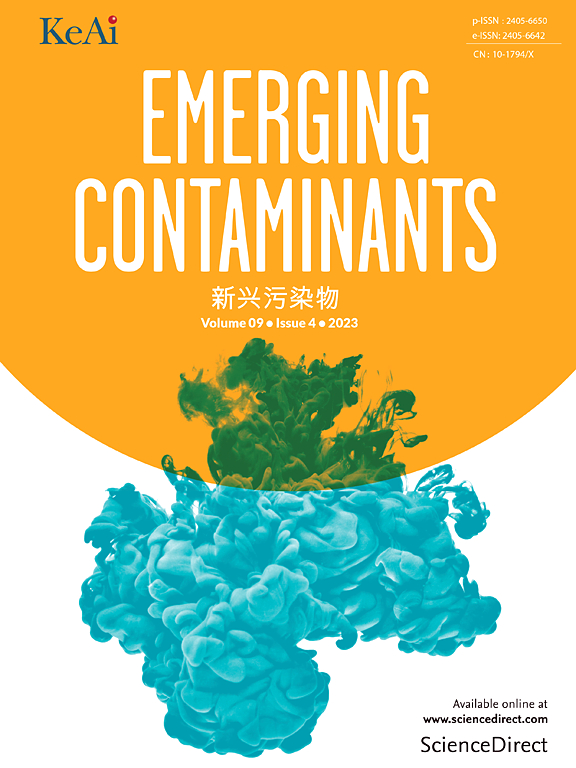Targeted and non-targeted LC-MS analysis of microcystins in Clarias gariepinus from fishponds
IF 6.9
2区 环境科学与生态学
Q1 ENVIRONMENTAL SCIENCES
引用次数: 0
Abstract
Cyanotoxins produced by cyanobacteria are formidable threats to aquatic ecosystems and public health worldwide. The potential health risks associated with cyanotoxins from contaminated fishponds are becoming a growing concern, as cyanotoxin production has steadily increased over time in these aquatic environments. Therefore, this study aims to utilize targeted and non-targeted Liquid Chromatography Mass Spectrometer (LC-MS) analytical methods to detect cyanotoxins in catfish (Clarias gariepinus) tissue harvested from fishponds. For detecting cyanotoxins in fish tissue utilizing the non-targeted approach, high-resolution MS/MS spectra data obtained from the analysis were converted to mzML format, analyzed with the Global Natural Product Social (GNPS) Library and CANOPUS annotations for LEVEL 3 metabolite identification, and visualized as a molecular network in Cytoscape. Regarding the targeted method, the toxin identification and quantification were achieved by comparing samples spiked with known concentrations of MC-RR and YR to an authentic toxin standard. The results of the target analysis showed that microcystin variant MC-RR was not detected in the fish tissue. The MC-YR variant was detected in the intestines and gills of Clarias gariepinus at concentrations of 13.2–10.6 μg/g and 1.5–13.9 μg/g, respectively. The muscle tissues across all fish ponds showed MC-YR concentrations between 10.5 and 16.06 μg/g. The highest concentration of MC-YR was found in the liver tissue in pond 6 (20.9 μg/g). The untargeted LC-MS method led to the identification of a larger number of cyanometabolites in the fish tissue, such as aeruginosins, anabaenopeptins, microginins. Non-toxic secondary metabolites like octadecadienoic acid, while phosphocholine (PC), ethanesulfonic acid, pheophorbide A, microcolins, cholic acid, phenylalanine, amyl amine and phosphocholine (PC), triglyceride (TG), phosphocholine (PC) and sulfonic acid derieved from cyanobacteria, fish and anthropogenic sources were also detected in the fish tissues. The non-targeted analysis facilitates the identification of both unexpected and unknown compounds.
鱼塘鱼中微囊藻毒素的靶向和非靶向LC-MS分析
蓝藻产生的蓝藻毒素对水生生态系统和全球公众健康构成巨大威胁。来自受污染鱼塘的蓝藻毒素的潜在健康风险正日益受到关注,因为这些水生环境中的蓝藻毒素产量随着时间的推移稳步增加。因此,本研究旨在利用靶向和非靶向液相色谱质谱(LC-MS)分析方法检测鱼塘鲶鱼(Clarias gariepinus)组织中的蓝藻毒素。为了利用非靶向方法检测鱼类组织中的青藻毒素,从分析中获得的高分辨率MS/MS光谱数据被转换为mzML格式,使用Global Natural Product Social (GNPS) Library和CANOPUS注释进行分析,用于3级代谢物鉴定,并在Cytoscape中可视化为分子网络。对于靶向方法,毒素鉴定和定量是通过将添加已知浓度MC-RR和YR的样品与真实的毒素标准进行比较来实现的。靶分析结果显示,在鱼组织中未检测到微囊藻毒素变体MC-RR。MC-YR突变体在鸡Clarias gariepinus的肠道和鳃中检测到的浓度分别为13.2 ~ 10.6 μg和1.5 ~ 13.9 μg/g。所有鱼塘的肌肉组织MC-YR浓度均在10.5 ~ 16.06 μg/g之间。MC-YR在6号池肝脏组织中浓度最高(20.9 μg/g)。非靶向LC-MS方法在鱼组织中鉴定出大量的氰代谢产物,如aeruginosins, anabaenopeptin, microginins。在鱼类组织中还检测到来自蓝藻、鱼类和人为来源的无毒次生代谢物,如十八烯二烯酸、磷酸胆碱(PC)、乙磺酸、磷酸酯A、微柱、胆酸、苯丙氨酸、戊胺和磷酸胆碱(PC)、甘油三酯(TG)、磷酸胆碱(PC)和磺酸。非靶向分析有助于识别意想不到的和未知的化合物。
本文章由计算机程序翻译,如有差异,请以英文原文为准。
求助全文
约1分钟内获得全文
求助全文
来源期刊

Emerging Contaminants
Medicine-Public Health, Environmental and Occupational Health
CiteScore
10.00
自引率
6.70%
发文量
35
审稿时长
44 days
期刊介绍:
Emerging Contaminants is an outlet for world-leading research addressing problems associated with environmental contamination caused by emerging contaminants and their solutions. Emerging contaminants are defined as chemicals that are not currently (or have been only recently) regulated and about which there exist concerns regarding their impact on human or ecological health. Examples of emerging contaminants include disinfection by-products, pharmaceutical and personal care products, persistent organic chemicals, and mercury etc. as well as their degradation products. We encourage papers addressing science that facilitates greater understanding of the nature, extent, and impacts of the presence of emerging contaminants in the environment; technology that exploits original principles to reduce and control their environmental presence; as well as the development, implementation and efficacy of national and international policies to protect human health and the environment from emerging contaminants.
 求助内容:
求助内容: 应助结果提醒方式:
应助结果提醒方式:


